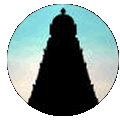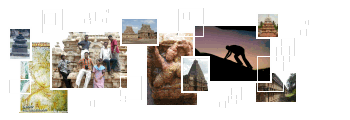 |
 |
 |
http://www.varalaaru.com A Monthly Web Magazine for South Asian History [187 Issues] [1839 Articles] |
 |
 |
 |
http://www.varalaaru.com A Monthly Web Magazine for South Asian History [187 Issues] [1839 Articles] |
|
Issue No. 133

இதழ் 133 [ மார்ச் 2017 ] 
இந்த இதழில்.. In this Issue.. 
|
CHANDRASEKARASWAMI TEMPLE SCULPTURES BHUTA GANAS The bhuta frieze is running for both the vimana and the mukha mandapa. As like the Sri Viswanatha-Visalatchi shrine, the bhuta frieze in the Chandrasekaraswami shrine is also a remarkable feature. Ornaments, dressing, amusements and the performing arts that prevailed in the society are pictured. The ganas are depicted in active posture; mostly in dancing gestures or frolicking with the swans, handling instrument, frisking or conversing with the neighbour. In addition, swan, tortoise, snake, owl, monkey are also shown in the series. Overall the series gives a lively experience. Female ganas are absent whereas monkey faced ganas are seen. The ganas are adorned with short attire and decked with various ornaments. The elongated ears are decked with either pootu kundala or patra kundala and some are seen without any kundalas. The locks are arranged as jatabhara and decked with head ornament, but for some of the ganas simply gathered and knotted. Charapali or beaded mala or chavadi are adorned in the neck; bangles, armlets are the ornaments in the hand. Udarabanda is of different patterns, for most of the ganas it is bow knotted in the belly which looks like vastra udarabanda whereas for some it is like interlocking chains or patterned chains. The yajnopavita is worn in upavita fashion. While Sri Viswanatha shrine gana series carries peacock a frequent depiction, here swans replace it. Swans either single or a pair or a gana frolicking it are seen. The birds are depicted in active posture with its wings spread and mouth wide open. Twittering pairs are seen at two places, facing each other. Gana frolicking with the swan is seen both on the northern and southern side, at one place the gana is peeking inside its mouth by wide opening the beak. Every corner is adorned with simha or yazhi and the platforms formed in the junctions are depicted with birds or animals in resting posture. In some of the platforms Nandi is depicted in the usual seated posture. Gana, bull, monkey, lying in relaxed postures with head resting on the floor of the platform are seen at some places. A pair of owl, animal carrying its young ones and baby Krishna in reclining posture also forms part of the depiction. Hands of the ganas are positioned in various ways either raised up or stretched down or folded in half way and showing either a mudra or a hasta. Some of the ganas are seen in gestures like pataka, recita, danda and some are seen with the gestures of kataka, tarjani, vismaya. At some places ganas are paired in gestures. On the northern side a pair is carrying the plank. Instruments like talam, cirattaikinnari, flute, mattalam, idakkai, conch are seen. Both the instrumentalists and the other performers are with their head tilted upward, with vibrant body postures and other gestures show their total involvement in the performance. The gana series in the second tala also possess the same features as found in the first tala.
THE SCULPTURES IN THE VIMANA Hara elements, nasikas in the harantara, the square sputitas in the harmaya of the second tala, griva koshthas and the walls of the griva are adorned with sculptures and bas-relief sculptures. Most of the sculptures in the vimana lost its originality due to refurbishment.
SCULPTURES IN THE GRIVA KOSHTHAS Umasahita, Vishnu, Dakshinamurthy, Brahma are the deities found in the east, west, south and north respectively in the griva koshthas. Vishnu is seated in suhasana on a pitha with his front right hand in abhaya and the front left hand is placed on the thigh whereas his back hands are in kartari mudra and carry chakra in the right and sankha in the left. In kritamakuta and silk dress he is also richly adorned with ornaments.
On the east, both the god and the goddess are seated on a pitha in utkutikasana. In jatamakuta and short attire the god is decked with all usual ornaments. His back hands in kartari mudra carry axe in the right and deer in the left. The front left hand is embracing the goddess whereas his front right hand is positioned as like pointing her grace. The goddess seated to his left in the front, between his legs is adorned with karanda makuta, long attire and all usual ornaments, placed her right hand on the floor of the pedestal and the left hand is carrying the lotus. Breast band is absent. Both with their head tilted left, cozily seated in bright grin.
Dakshinamurty is seated in virasana on a hillock with his front right hand in chin mudra carrying akshamala whereas the front left hand is in kataka. The back hands are in kataka and carry snake in the right, fire in the left. In jatabhara and short attire he is decked with various ornaments. The deity is surrounded by rishis and ganas. Brahma is seated in suhasana on the padma pedestal with his front right hand in abhaya and the front left hand is placed on his thigh whereas his back hands carry objects; akshamala in the right and lotus in the left. His locks are arranged as jatamakuta and he is decked with long attire and various ornaments.
SCULPTURES IN THE HARMAYA OF THE SECOND TALA The square sputitas in the second tala are adorned with bas-relief sculptures. Totally there are six relief figures each two on west, north and south while on the eastern side the vritta sputita is seen. On the northern side two females, on the southern side two males and on the western side a male and a female are seen.
Both the females on the northern side are whisk bearers and are standing straight while the one on the east with her legs in sama while the other one placed in trysra. Both are carrying whisk on their right hand and the left hand is stretched to their side. The female on the east is resting the whisk on the right shoulder while the other is resting over the shoulder stretching behind the neck. Their locks are gathered in the apex and knotted and the excess locks flows like a pony tail from the knot. Patrakundala or pootukundala, bangles, armlets, charapali, hip ornaments are adorned by them. Both are wearing a long attire extending upto their ankle but breast band is absent. The female in the west is adorned with same dressing and ornaments but in profile posture and in anjali hasta. Among the three male figures, two are found in the south and one in the west. Among the three the one on the south east is a rishi with beard and mustache. All the three are with their one hand in katyavalambita and their other hand folded upwards and showing kataka mudra, except the rishi the other two are carrying flower. As like the females all the three are wearing a long attire extending upto to their ankle and adorned with ornaments like pootukundalas, bangles, armlets, charapali. The vastra yajnopavita is worn in upavita style. All the three are standing straight but their foot placed differently, the males on the south have placed in trysra whereas the male on the west placed his left leg in sama and the right leg in parsva.
|

சிறப்பிதழ்கள் Special Issues 

புகைப்படத் தொகுப்பு Photo Gallery 
|
| (C) 2004, varalaaru.com. All articles are copyrighted to respective authors. Unauthorized reproduction of any article, image or audio/video contents published here, without the prior approval of the authors or varalaaru.com are strictly prohibited. | ||